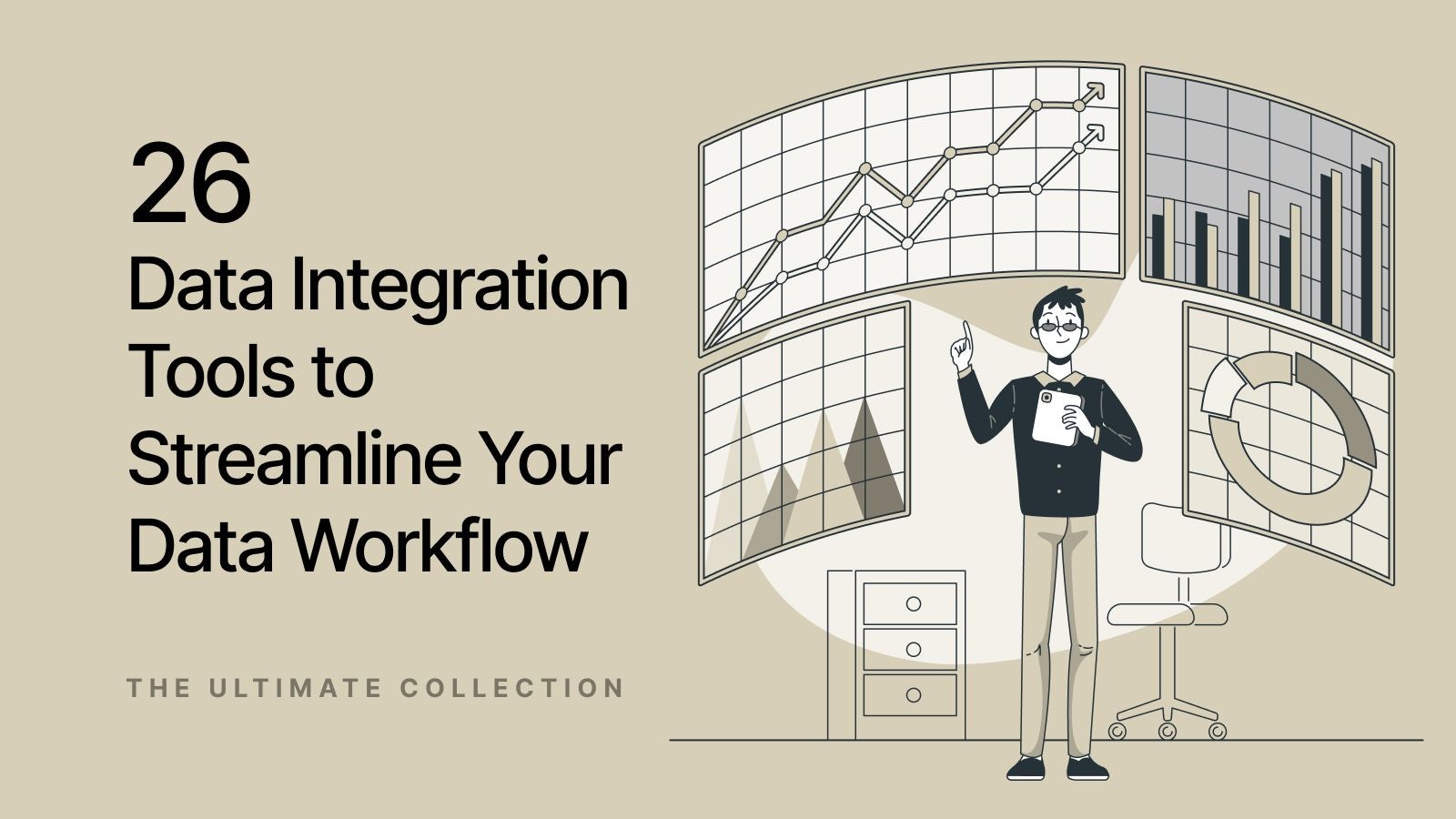Ever feel like you're drowning in a sea of data, trying to get everything to play nicely together? Trust us, you're not alone.
Data integration is pretty much like trying to fit puzzle pieces from different boxes into a single, coherent picture. Fun, right? Well, maybe not always, but incredibly important for sure!
But here's the catch: diving into the world of data integration tools can be a tad overwhelming. There's just SO much out there.
That's why we've taken on the task of picking out 25 tools and platforms just for you.
No more guesswork, no more endless Google searches. We've got you covered!
💾 Why is Data Integration Important?
Our paper mess isn't on desks anymore – it's on our computers. Data is sprinkled everywhere: spreadsheets, cloud services, local files, you name it.
But here's the tea: having a ton of data is cool, but what's the point if it's all over the place?
This is where our hero, data integration, comes to save you. Integrated data means you get a 360-degree view of everything. Imagine trying to piece together a story from a bunch of scattered pages.
Now, imagine if those pages were sorted, bound, and handed to you as a best-selling novel. That's the power of data integration! It gives you a clearer picture, actionable insights, and a competitive edge.
In essence, data integration is your ticket to making smarter decisions, faster actions, and staying ahead of the curve.
🗂️ What are Data Integration Tools?
Data integration tools basically take all your different data sources and smash them together into one place.
Maybe you've got data stored in a bunch of databases, cloud apps, even files on your computer. These tools connect to all those places and pull the data out.
Then they need to clean things up and make all the data formats and fields match so it actually makes sense together. Once that's done, they dump it into one big data pot, something like a data warehouse.
Now you've got all your info in one spot instead of scattered everywhere. The integration tools will also keep syncing new data as things update so your combined dataset stays current.
From there, other analytic programs and reporting tools can easily query or dig into the data. No more hunts across multiple systems.
🖥️ 25 Best Data Integration Tools
1. Hevo Data

Hevo Data
This is the all-star player you didn't know you needed on your team. Imagine a tool that not only fetches your data but also preps it up to be the best player in your analytics game. That's Hevo Data for you!
Key Features
- Automated Data Integration: You don't need to chase your data anymore. It pulls data from different sources like databases, cloud applications, or even those pesky SDKs, and integrates them smoothly into the destination you want.
- Real-time Data Transfer: In the age of instant coffees and 5G, waiting is so yesterday. Hevo gets this. It offers real-time data transfer ensuring that your analytics is always based on the freshest of data. No more outdated insights.
- No-Code Pipeline Creation: If you thought data integration sounds techy and scary, think again. Design and automate your data pipelines without writing a single line of code.
- Easy Transformation: Data comes in all shapes and sizes. And sometimes, in languages we don't understand. Hevo's got your back here. It allows you to transform data on the move, making sure it's in the perfect shape and format by the time it reaches its destination.
- Error Handling: Let's face it, errors happen. But with Hevo, they don't have to be show-stoppers. The tool provides real-time alerts and a user-friendly dashboard that tells you exactly what went wrong. So, you can get things back on track in no time.
2. Boomi
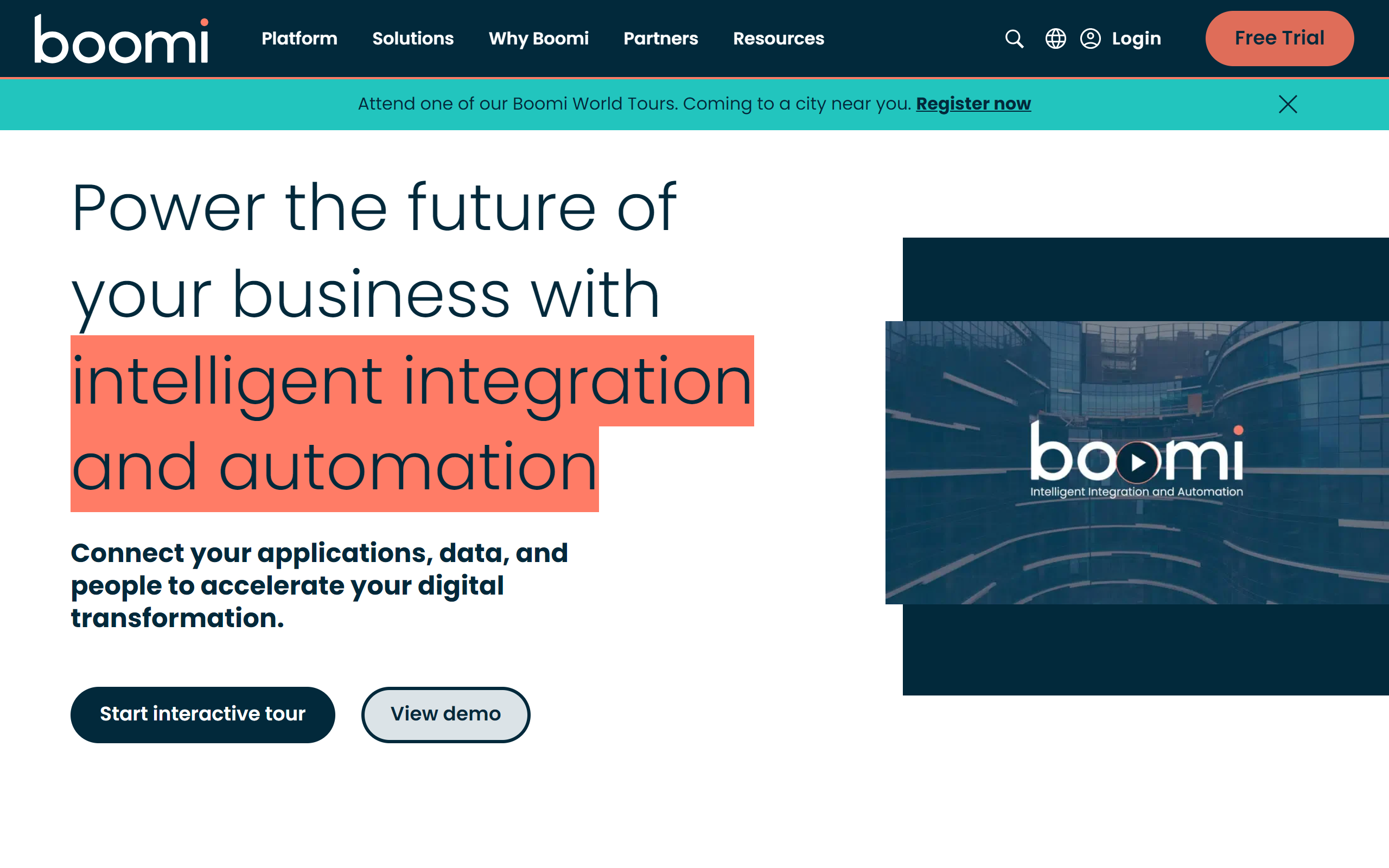
Boomi
Boomi is one of the best data integration tools for pulling together your crazy scattered data landscape, smoothing it all over, and providing one simple portal to make sense of it all without dragging multiple systems around.
Key Features
- Connectivity: It can link to a massive list of data systems like databases, SaaS apps, cloud services, all that jazz. Whether it's SQL, NoSQL, APIs or other formats, Boomi knows how to talk to pretty much anything.
- Transformation: Once it pulls your data in, it can reshape things to all sync up. Changing field names, types, structures - it cleans it up and preps it for the combined dataset.
- Workflow Automation: Boomi has a full environment to set up processes to routinely sync your integrated data. Things like scheduled refreshes, error handling, alerts when stuff breaks. Keeps everything up to date. Integrated data, enriched with external information, gets you a 360-degree view of everything.
- Governance: There are tools to monitor your integrated data flows and keep them compliant. Control who sees what, audit logs of changes. Helps prevent messing stuff up.
- Simplified Access: It gives you a central place to query all your now united info easily. Dashboards, api access, whatever you need to analyze without worrying about where it came from originally.
3. Zapier
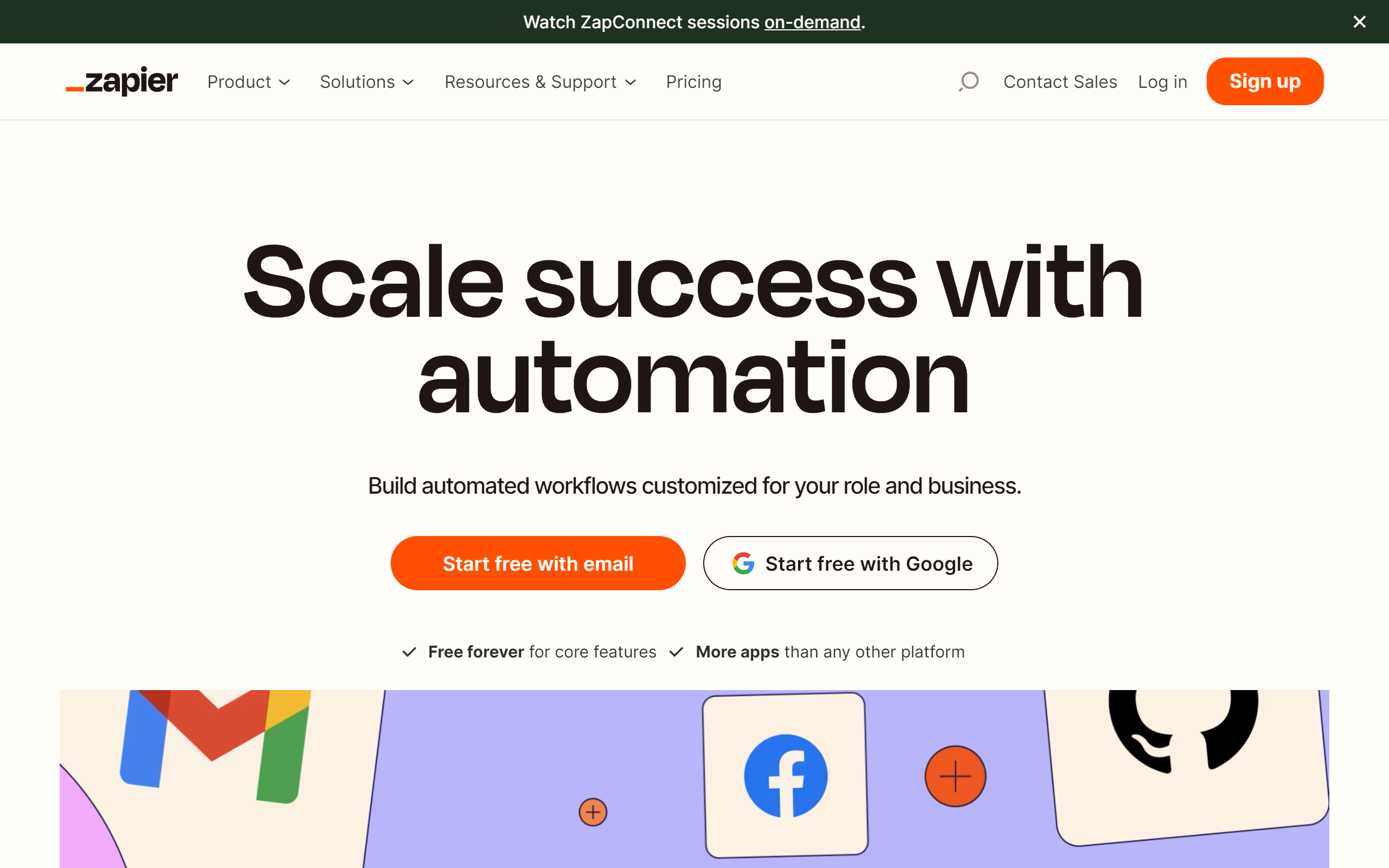
Zapier
This tool is a data integration solution for seamlessly gluing together web tools without code. It lets you lets you automatically sync stuff between different web apps and services. Saves hours of redundant clicking to stay in sync.
Key Features
- Connectivity: It hooks into probably well over a thousand different platforms, from Google Docs to Slack to your favorite CRM. As long as it's got an API, Zapier can probably chat with it.
- Automated Workflows: Called "Zaps", you can set these suckers up to watch one app for a new record or change, then auto-trigger an action in another app. Real time-saver.
- Conditional Logic: Zaps aren't just straight pipes between apps. You can add IF/THEN decisions to only sync stuff under certain conditions.
- Filters: When snatching data between apps, Zapier lets you fine tune exactly what fields and records get passed along. Leave the junk behind.
- Schedules: Not all workflows need to run in real time. Zaps can run on timers like every hour, day, etc. to keep synced data updated on a cadence.
4. Talend

Talend
If you need bulletproof repeatable ETL, better data hygiene, integration with tons of sources, or regulatory oversight, Talend is one of the data integration platforms that nails a lot of those big data wrangling jobs so you don't have to stress the small stuff by yourself.
Key Features
- Connectivity: It can grab data from pretty much any source you throw at it - databases, cloud apps, flat files, APIs, you name it.
- ETL Jobs: Talend excels at Extract, Transform, Load workflows (ETL for short) to pull data out of one system, modify it as needed, and pump it into another target.
- Data Quality: As part of transformations, it can clean data types, find and fix errors, consolidate duplicates and so on to get your info shipshape.
- Batch Processing: For huge datasets that need routine assembly, Talend can set up dependable recurring jobs to churn through terabytes overnight.
- Regulatory Adherence: If you need to prove your data processes are on the up-and-up, Talend provides auditing tools for compliance with standards in things like finance and healthcare.
5. SnapLogic
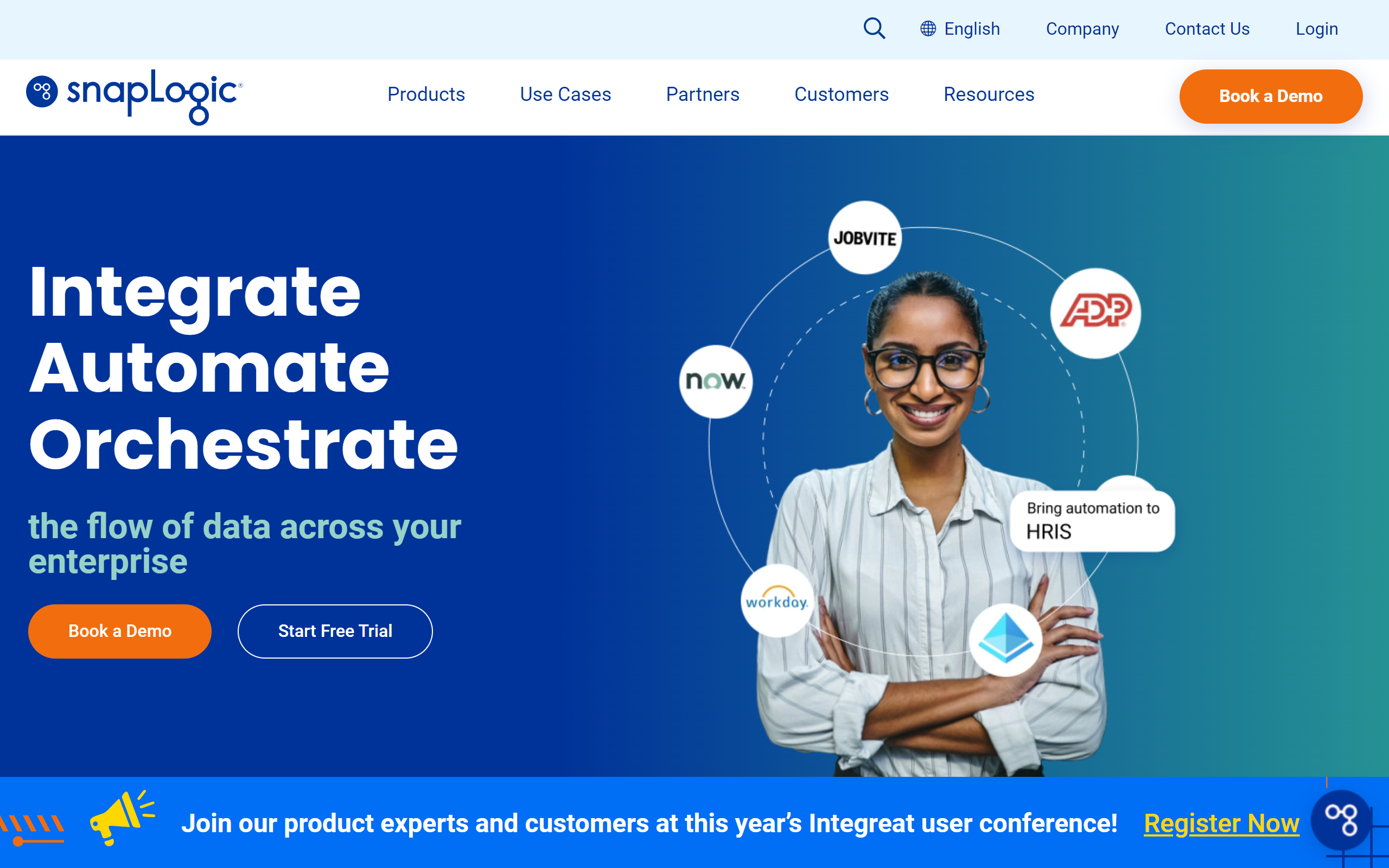
SnapLogic
SnapLogic is another useful data integration tool for shaping data between different systems and transforming it for your specific needs. A lot of big companies use it for their data flows.
Key Features
- Connectivity: It can plug into a huge variety of systems like databases, cloud apps, file stores, basically anything with an API or driver.
- Workflows: You can string together tasks in pipelines to automate fetching data from here, massaging it over there, and depositing it somewhere else as needed.
- Integration Templates: SnapLogic has tons of pre-made templates for common workflows like ETL, API syncing, data transformations, and others that you can tweak instead of starting from scratch.
- Visual Design: The interface lets you just click stuff together in a drag-and-drop way instead of coding it all. Easy to customize flows.
- Reusable Components: Got steps you reuse a bunch? Create them once as a module and call them wherever in your pipelines to DRY up your workflows.
6. Jitterbit

Jitterbit
Jitterbit is another data integration tool that can zip data between different apps and systems for you. A lbunch of companies use it for their data wrangling needs.
Key Features
- Connectivity: It hooks up with a ton of stuff like databases, cloud apps, flat files, you name it. As long as it's got an API or some kind of driver, Jitterbit knows how to talk to it.
- Automation: You can throw together workflows (they call 'em scenarios) to have info siphon from one place into another on a set schedule or trigger. Set it and forget it!
- Transformations: Part of moving your data around is scrubbing it up to spec. Jitterbit can handle changing field types, filtering junk, standardizing formats, and so on.
- Monitoring: Keeps tabs on your scenario runs so you know if anything is busted or runnin' slow. Alerts if it detects issues too.
- Templates: They have pre-made templates for common tasks that you can tweak instead of starting cold. Save time over reinventing the wheel each time.
7. Oracle Data Integrator
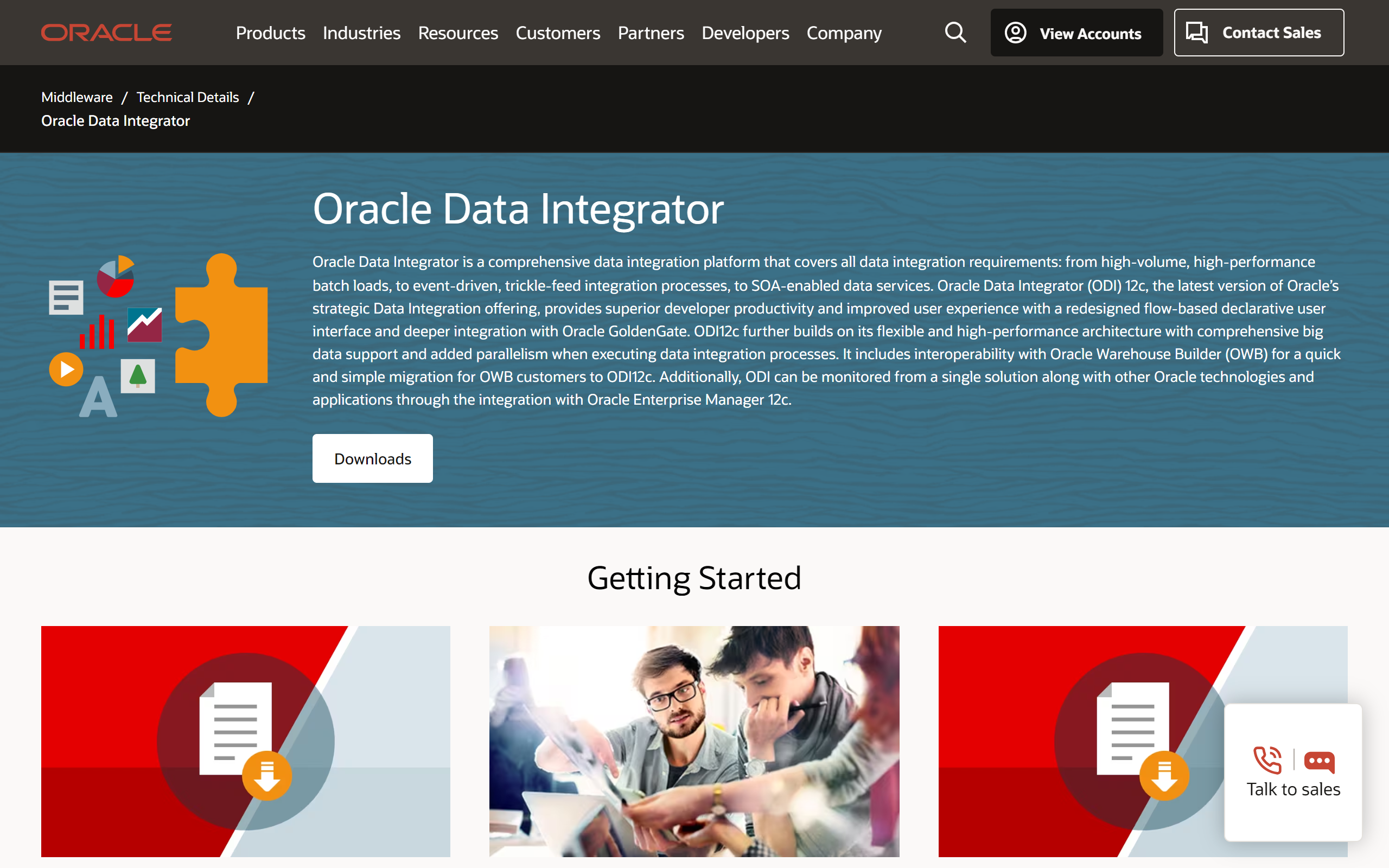
Oracle Data Integrator
You know that feeling when a new trendy cafe opens up in your neighborhood and suddenly everyone's talking about it? That's kind of like what Oracle Data Integrator (ODI) is in the data world.
Key Features
- ELT Over ETL: Most tools go the ETL way (Extract, Transform, Load), but ODI is like, "Nah, let's shake things up!" It goes ELT (Extract, Load, Transform). Think of it as grabbing all your shopping first, then deciding how to bag it. Quicker and way less hassle.
- Knowledge Modules: Imagine having cheat codes for a video game. Knowledge Modules (or KMs) are ODI's cheat codes. They're these ready-to-use bits that show data how to get moving.
- Plays Well With Others: Whether your data's lounging on a cloud, hiding in a database, or chilling on a web service, ODI has your back.
- Just Tell It What, Not How: With ODI, you just point and say, "I want that," and it figures out how to make it happen.
- Mistake Handler: Everyone trips up now and then, right? When ODI stumbles on an error, it doesn’t just drop the ball. It tells you where it goofed so you can get things back on track. Super handy for those "Oops, my bad!" moments.
8. Celigo

Celigo
If you've been on the lookout for data integration software that adds a sprinkle of ease and a little bit of fun to the data world, give Celigo a try.
Key Features
- Integrations: You know that feeling of effortlessly switching between your favorite streaming apps? Celigo is a master of making integrations feel like a walk in the park. Just a click here, a drag there, and you're integrated.
- Smart Wizards: Though we all wish we had a wand-wielding wizard at our disposal, Celigo's smart wizards come pretty close. They guide you step-by-step, making complex tasks feel less stressful.
- Customizable Flows: Whether you're crafting a simple path or going for that intricate data sculpture, Celigo’s here to assist.
- Sharing: You can create and share your stacks. Saves a lot of time.
- Token Love for Complex Logic: Forget digging deep into codes. With this data integration solution, you get these nifty tokens for API calls.
9. Skyvia
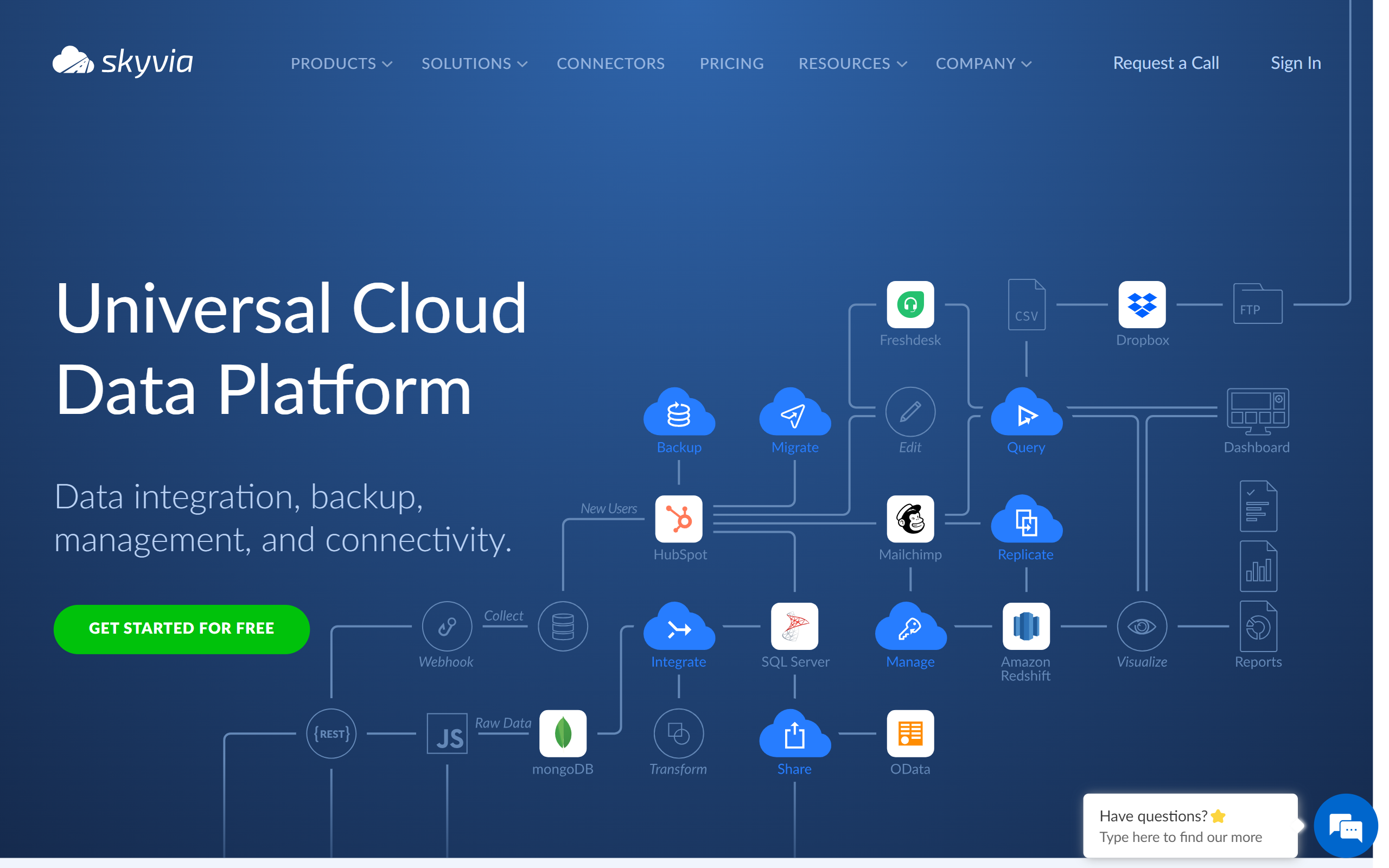
Skyvia
If you have to bring together different databases, apps, and files on a regular basis, Skyvia smooths it out with its visual workflows and reusable templates.
Key Features
- Connectivity: It can hook up to all sorts of systems like SQL databases, no-SQL databases, SaaS apps, pretty much anything with an API.
- Workflow Builder: Drag and drop tool for visually crafting your data flows without code. Pipe stuff from here to there.
- Transformations: As part of the workflows, it can adjust column names, types, and structures to clean data up as needed.
- Templates: Heaps of pre-built integration templates for common tasks that you can tweak to your needs. Saves design time.
- Scheduling: Whether it's daily, weekly, or on triggers, Skyvia lets you automate your integrations to run routinely in the background.
10. Fivetran
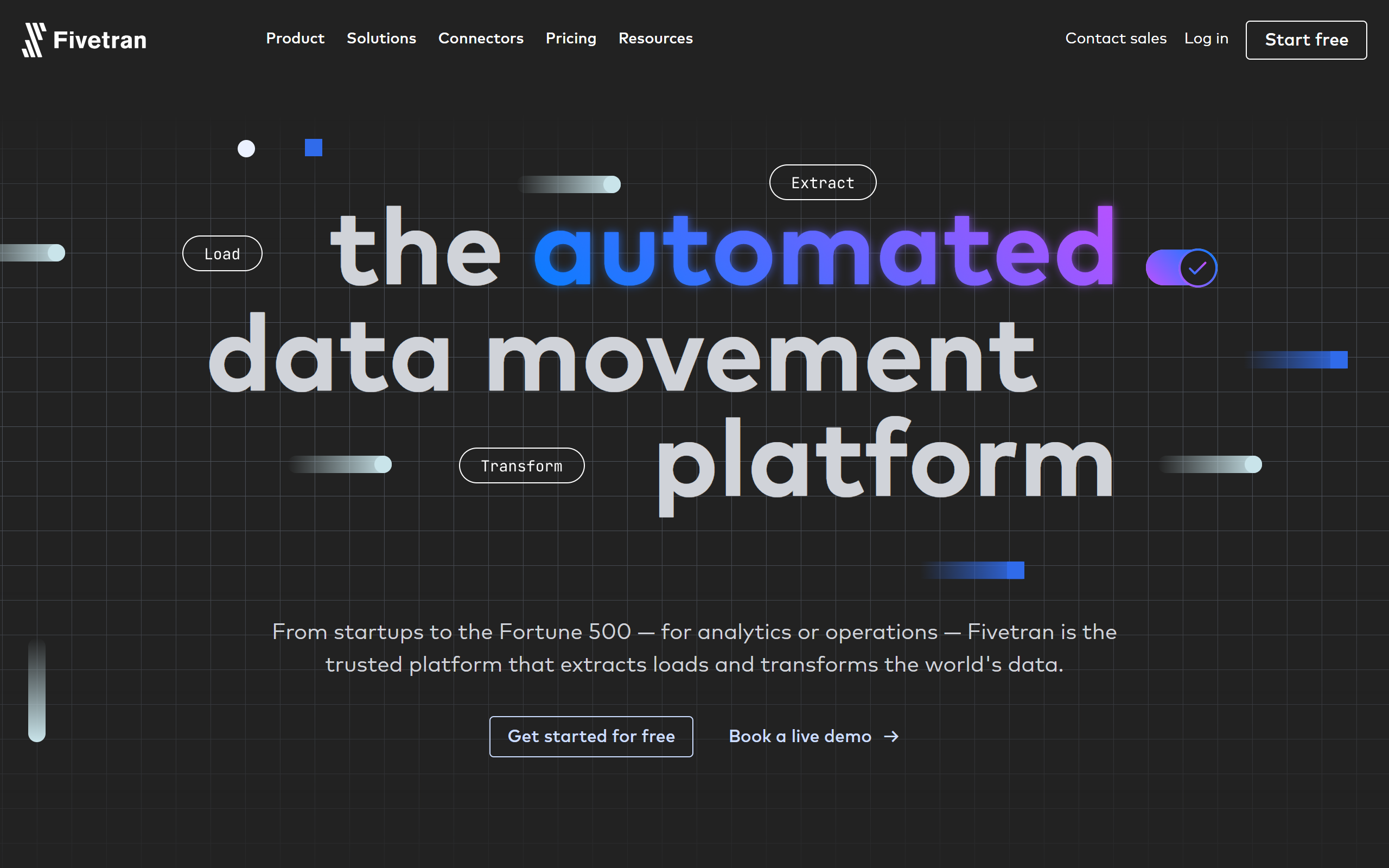
Fivetran
In the big world of data integration platforms, Fivetran is one of the best in data syncing. So, if you're dreaming of smooth sails on the data seas, give Fivetran a spin and let the adventure unfold.
Key Features
- Setting Up: Remember those slow cookers where you toss in the ingredients, set the timer, and voilà, dinner is served? Fivetran is the slow cooker of data. Just set up your connectors, and watch as your data effortlessly syncs.
- Centralized: Here everything’s in one place, making data playtime ten times more fun.
- Maintenance? Pshh, Not Here: If you're the kind who loves tech but not maintenance, Fivetran's will save you. It auto-updates, meaning you can sip your coffee without a worry in the world.
- Logbook: With Fivetran, you get audit log that tracks all changes. It's like having a diary that documents every adventure (or misadventure) your data's been on.
- Security: Fivetran ensures your data feels comfortable and secure, wrapped up in the best security protocols.
11. Stitch
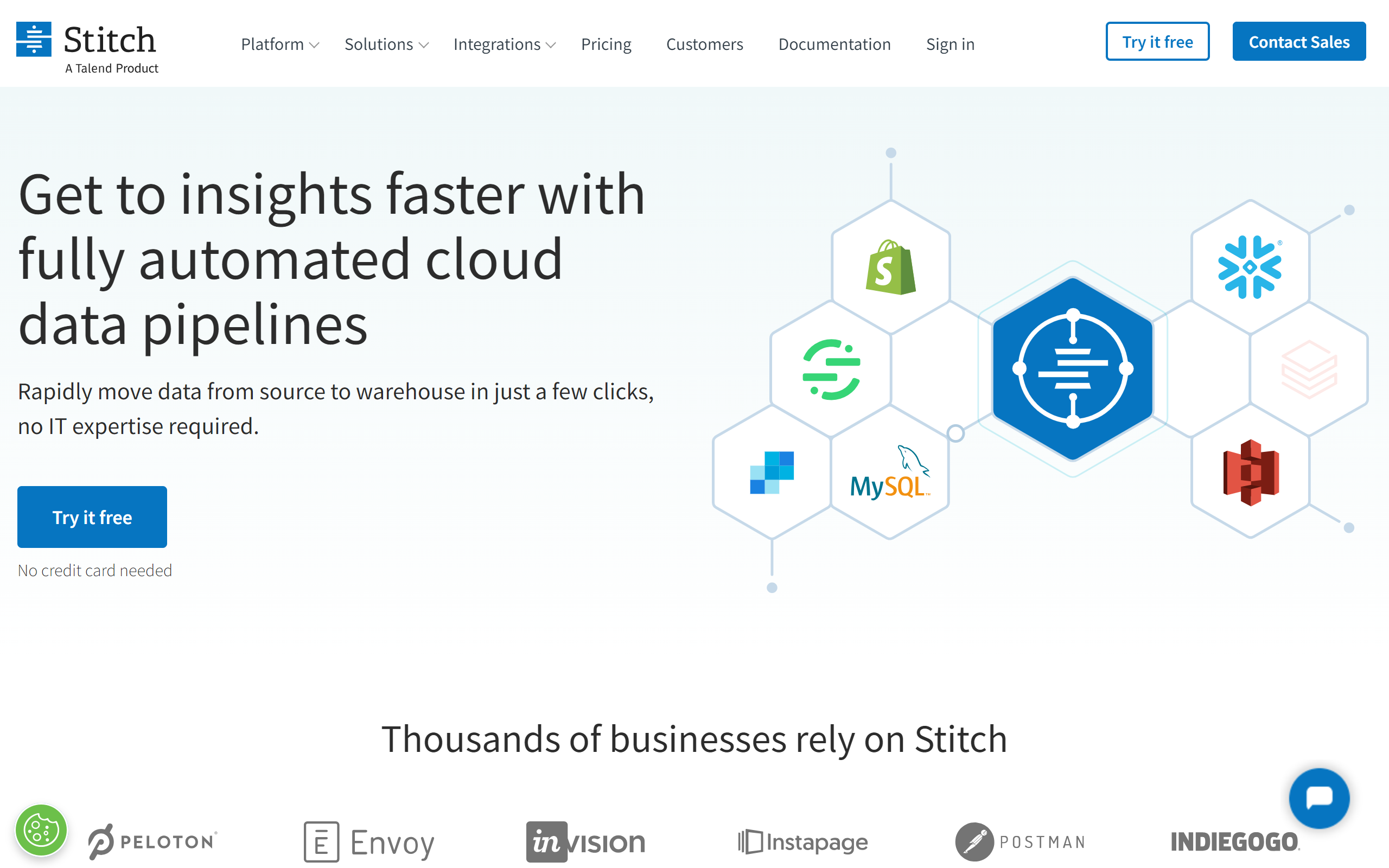
Stitch
This is one of the data integration tools for syncing up all your various data sources so they stay in lockstep. Lots of companies use it to keep their dataflows straight.
Key Features
- Connectivity: It'll hook into tons of databases like MySQL, PostgresSQL, warehouses like Snowflake. Basically anything with an API.
- Continuous Syncing: New data in one system? Stitch zips it over to the others in real time so everything's fresh. Set and forget.
- Transformations: As part of moving data around it can reshape columns, filter stuff, and tweak formats to keep fields matched up.
- Security: You can lock down access to different databases, set fields, encryption at rest so your stuff stays tight.
- Monitoring: See a history of syncs, check for errors, and confirm everything's right. Helps catch issues fast.
12. Integrate.io

Integrate.io
Here's another unified data integration platform that allows users to build complete data pipelines in a no-code/low-code environment. It lets anyone build full data workflows with zero hassle and keeps all your data flowing and accessible in one platform.
Key Features
- Connectivity: Coonects with 150 different data sources like Salesforce, Google Analytics, MySQL, REST APIs, and many others.
- Data Transformations: Want to remix your data? No problem! With Integrate.io, you can apply transformations as if you're tweaking the bass and treble. Perfect for getting that data tuned just right.
- Cloud, On-Premises Whether you're jamming in the cloud, on-premises, or you're a fan of both, Integrate.io's versatile setup has you grooving in any environment.
- Error Handling: Every now and then, a track might skip or a chord might sound off. But fear not! Integrate.io detects and manages errors like a pro, ensuring your data beats keep flowing seamlessly.
- Security: You wouldn't want anyone crashing your party, right? Integrate.io ensures your data is armed with the best security measures.
13. Informatica PowerCenter
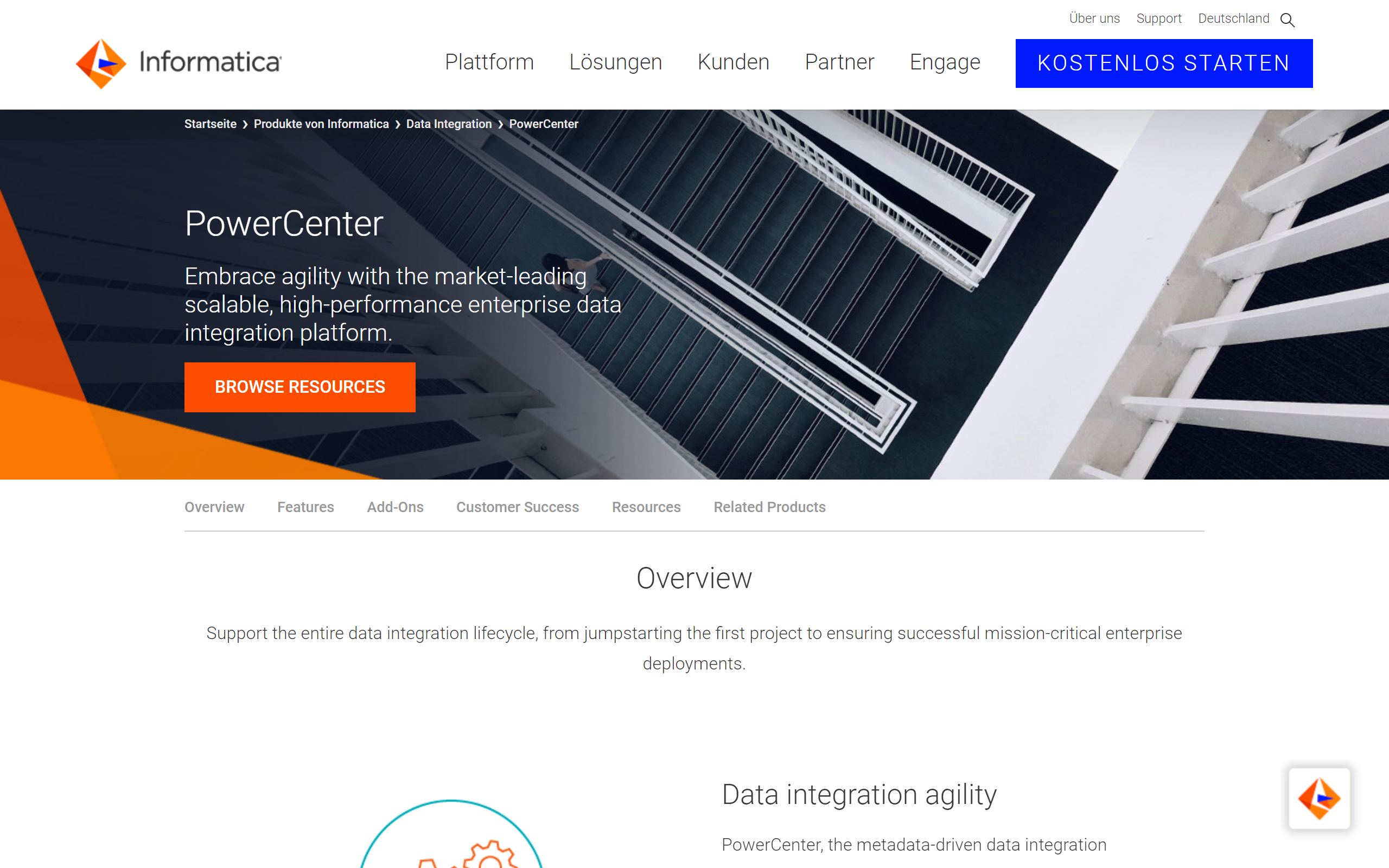
Informatica PowerCenter
PowerCenter is one of those heavyweight data integration tools that a bunch of huge companies rely on. It's been around forever so it's super robust.
Key Features
- Connectors: It talks to pretty much any data source under the sun. Traditional databases, cloud apps, files, weird legacy systems - if it's got ports PowerCenter can link in.
- ETL Workflows: Where it really shines is drag-and-drop designing of Extract, Transform, Load jobs to shuffle big datasets between systems.
- Transformations: As part of the ETLs it can clean types, structure, shapes data as needed with a ton of built-in functions.
- Reusable Objects: Build transform scripts, and queries once and call them up again anywhere. Saves major designing time.
- Manageability: It runs like a champ at massive scales, has tools for overseeing jobs/workflows, and can integrate tasks into pipelines.
14. Panoply
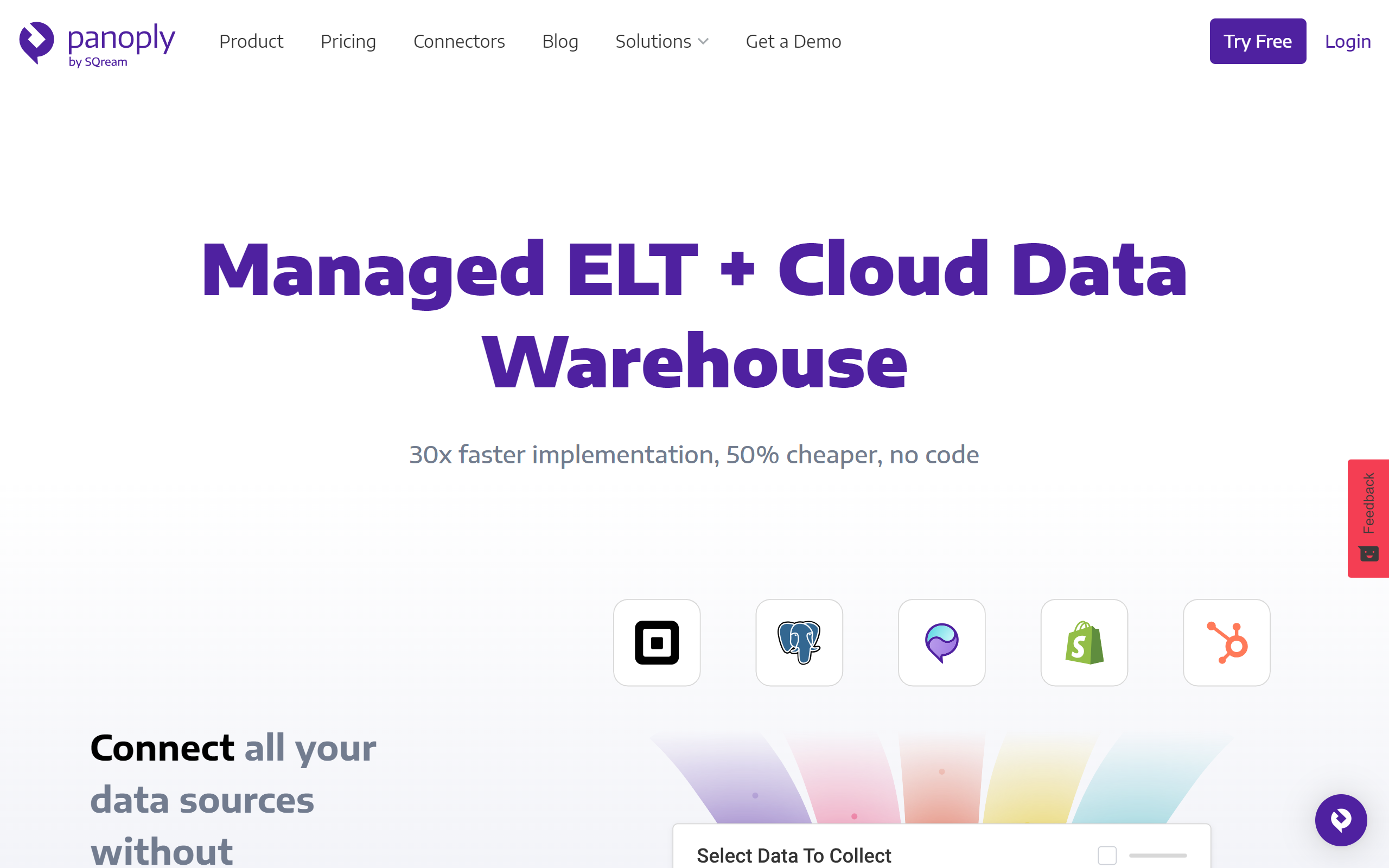
Panoply
Lots of customers use this data integration solution to migrate or access data easily. So whether you need weekend data dumps or real-time cloud migrations, Panoply moves it smooth without a bunch of coding busywork.
Key Features
- Connectors: It can plug into all the major data platforms like Snowflake, BigQuery, Redshift and more. Also SaaS apps.
- Transformations: As part of moving data around, it can massage columns, filter rows, clean up formats between sources.
- Smooth Workflows: Drag and drop tasks to build repeatable pipelines for syncing or loading information. Set it and forget it!
- Security: Handles encrypting data at rest and controls access permissions to different accounts and data sets.
- Monitoring: See a history of job runs, check for errors, confirm all's well. Lets you catch problems faster.
15. ZigWave
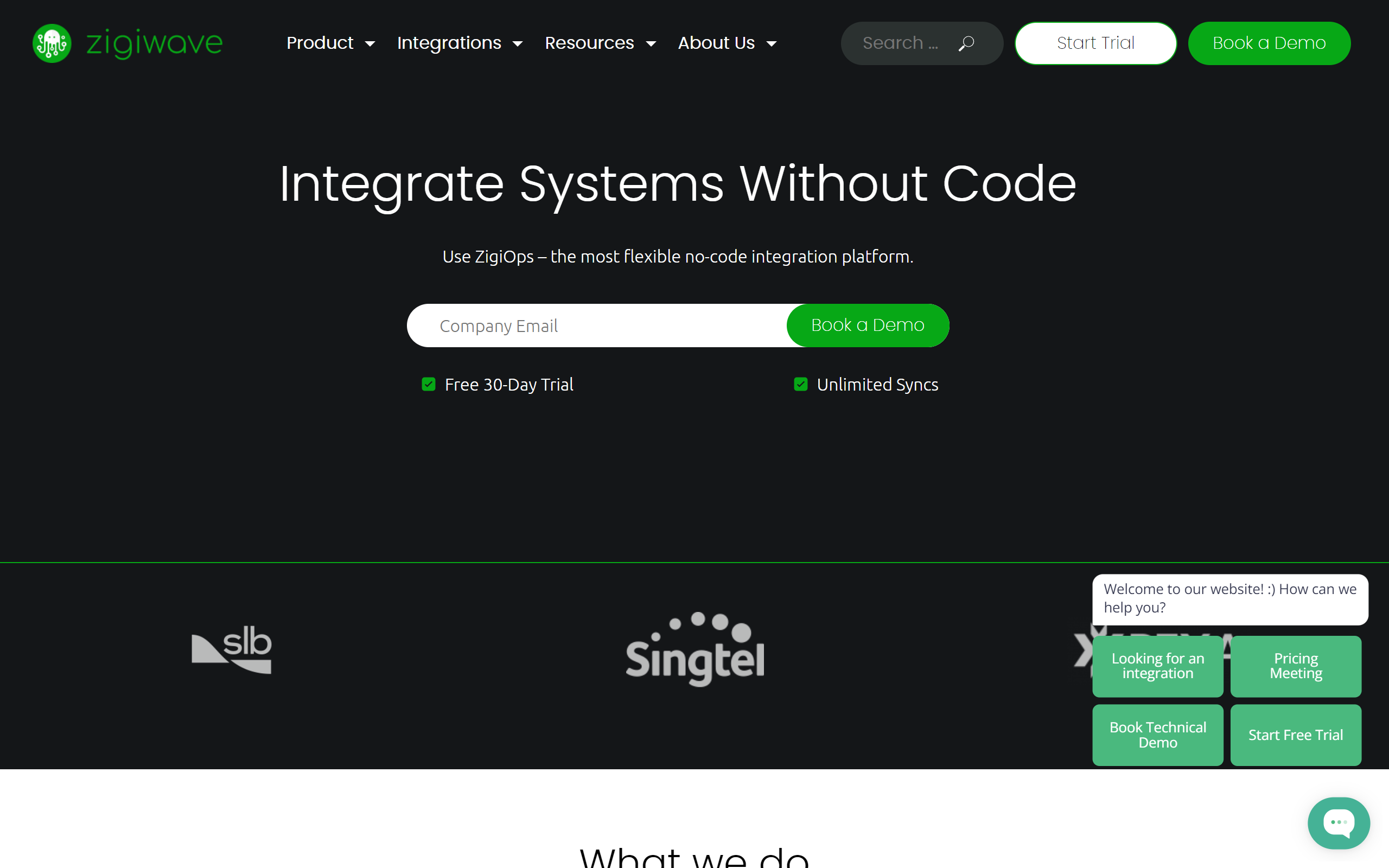
ZigWave
ZigWave is one of the best data integration tools for zipping information between different systems and sources. Lots of customers use it to sync up their distributed data.
Key Features
- Connecting: It hooks into heaps of databases, SaaS apps, storage services and more using APIs. Smooth integration.
- Workflows: Drop tasks into a visual builder to easily string together ETL style jobs for fetching, changing, and shipping out info.
- Transformations: As part of moving data around, it cleans things up by adjusting columns, standardizing formats, and filtering out the cruft.
- Schedules: Whether it's daily, weekly, or on demand, you can automate your data flows to run regular refreshes in the background.
- Security: Protects your stuff with encryptions and permissions so only the right eyes can access sensitive info as it travels.
16. Pentaho by Hitachi Vantara
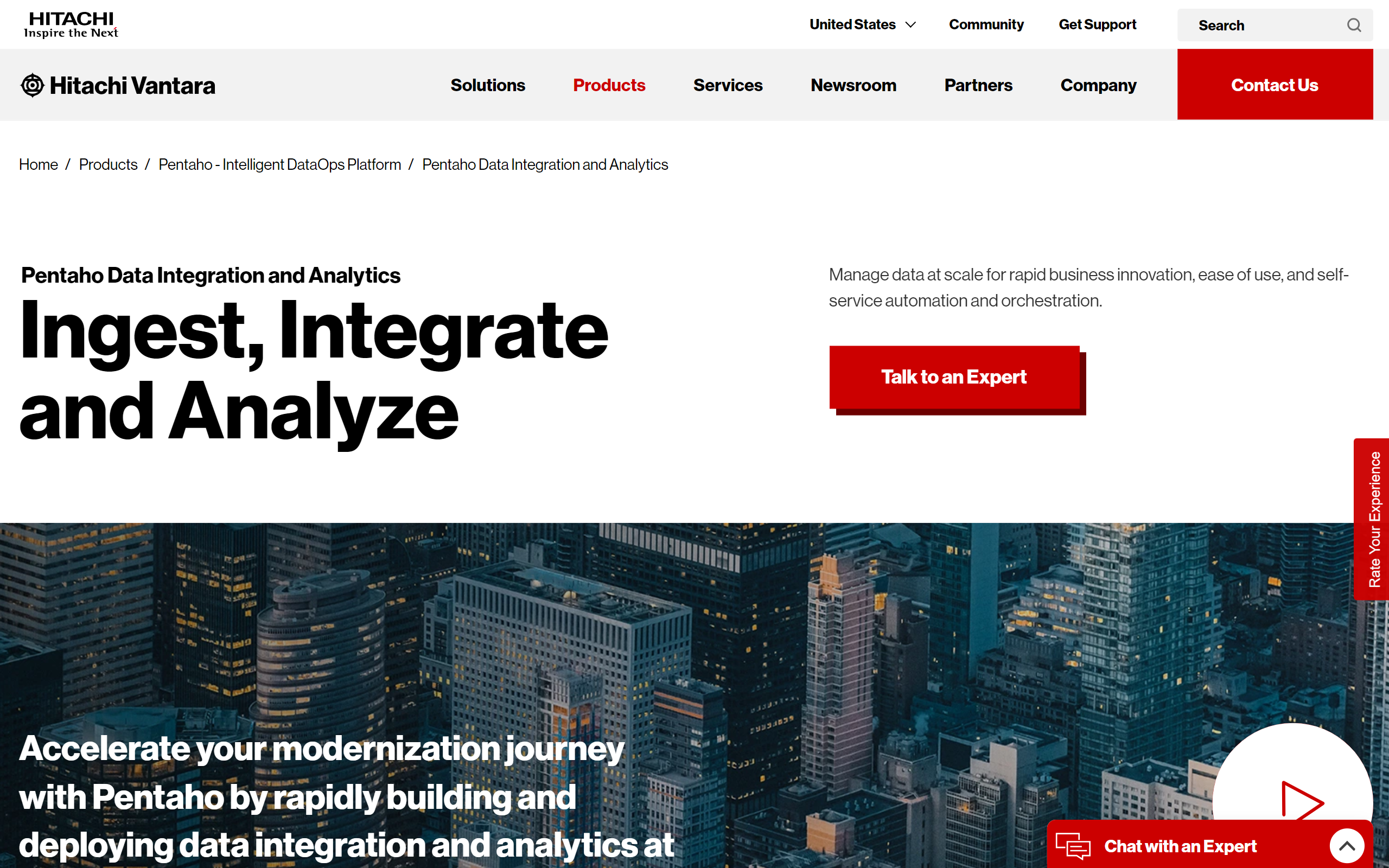
Pentaho by Hitachi Vantara
This is more than just a tool; it's a platform. One of those data integration platforms designed to make your life easier, decipher the cryptic, and light up the world of data with insights you never knew were beneath the surface.
Key Features
- End-to-End Data Integration: From raw, unstructured data to refined, analyzed insights, Pentaho can handle the entire flow.
- Analytics: Once the data is centralized, you can analyze and visualize it using interactive dashboards, reports, and more. Get insights without being a data science whiz.
- Extensible: It's not just about what Pentaho can do out-of-the-box. Thanks to its open-source roots, it's super customizable. You can mold it, adapt it, and let it grow with your business.
- Interactive Reporting: Pentaho's reporting capabilities aren't just about throwing numbers on a page. They're interactive, user-friendly, and seriously insightful.
- Extensibility: Through plugins and code-free scripting, the platform can be adapted for specialized needs. Customize it without totally reworking everything from scratch.
17. Qlik

Qlik
Qlik is one of the most popular data analytics platforms that lets you make sense of all your business info. This is one of the data integration tools that helps you manage tons of information.
Key Features
- Associative Data Modeling: Qlik builds linkages between different data elements so you can explore info from many angles. Everything's connected for exploring without constraints.
- Smart Visualizations: Get insights FAST with easily customizable viz like charts, graphs, and Geographic maps right on the app. No design or coding needed.
- App Building: Anyone can create multi-dimensional, interactive data apps just by dragging fields around. Share insights widely too without exporting crap elsewhere.
- In-Memory Analytics: Qlik's underlying engine processes everything in RAM for light speed analysis of huge datasets. No lag in finding what you need!
- Self-Service BI: From the C-suite to joe blogs analysing sales, Qlik lets business users perform DIY analytics and find fresh facts without IT's assistance.
18. Information Builders
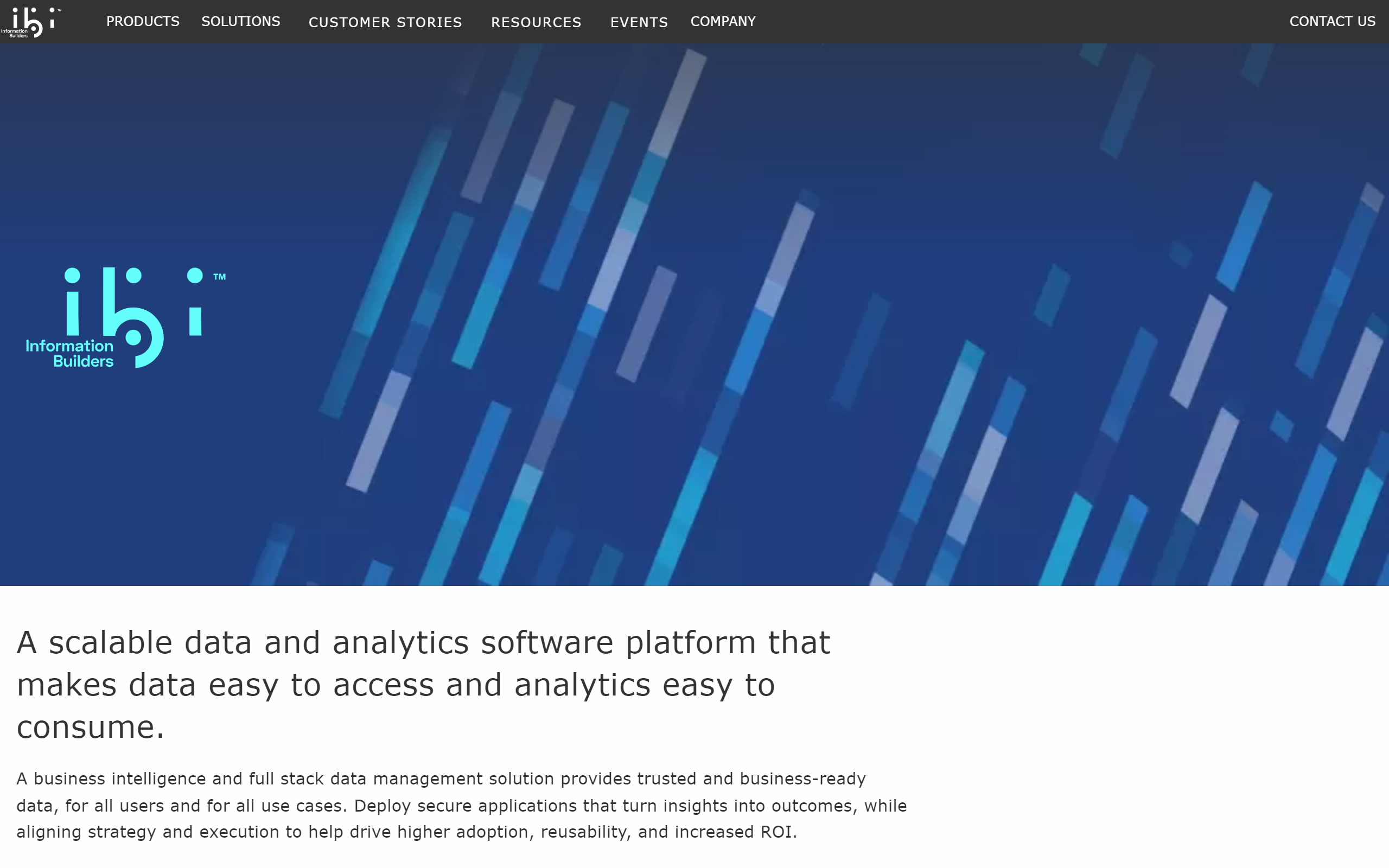
Information Builders
This is a business insight and analytics platform that can take all your disparate company data and make some sweet sense of it. Ibi has been serving businesses for decades with its top-tier data management and analytics solutions.
Key Features
- All-In-One Solution: ibi isn't just about one thing. From data integration and quality to analytics and visualization, ibi's got you covered.
- WebFOCUS: This is one of ibi's best features. A powerful BI and analytics platform, WebFOCUS is designed to serve insights on a silver platter, no matter your tech expertise.
- Visuals: Once your data's ready to party, ibi lets you work your analytic magic with intuitive dashboards, maps, charts, and more. No design degree is needed - just point and click fun.
- Mobility: With ibi's mobile apps, you can stay on top of business metrics even when you're on the go. Always stay in the know no matter where the road takes you.
- Platform: Slide ibi into your current infrastructure with ease via connectors, APIs and flexible architecture.
19. Adeptia
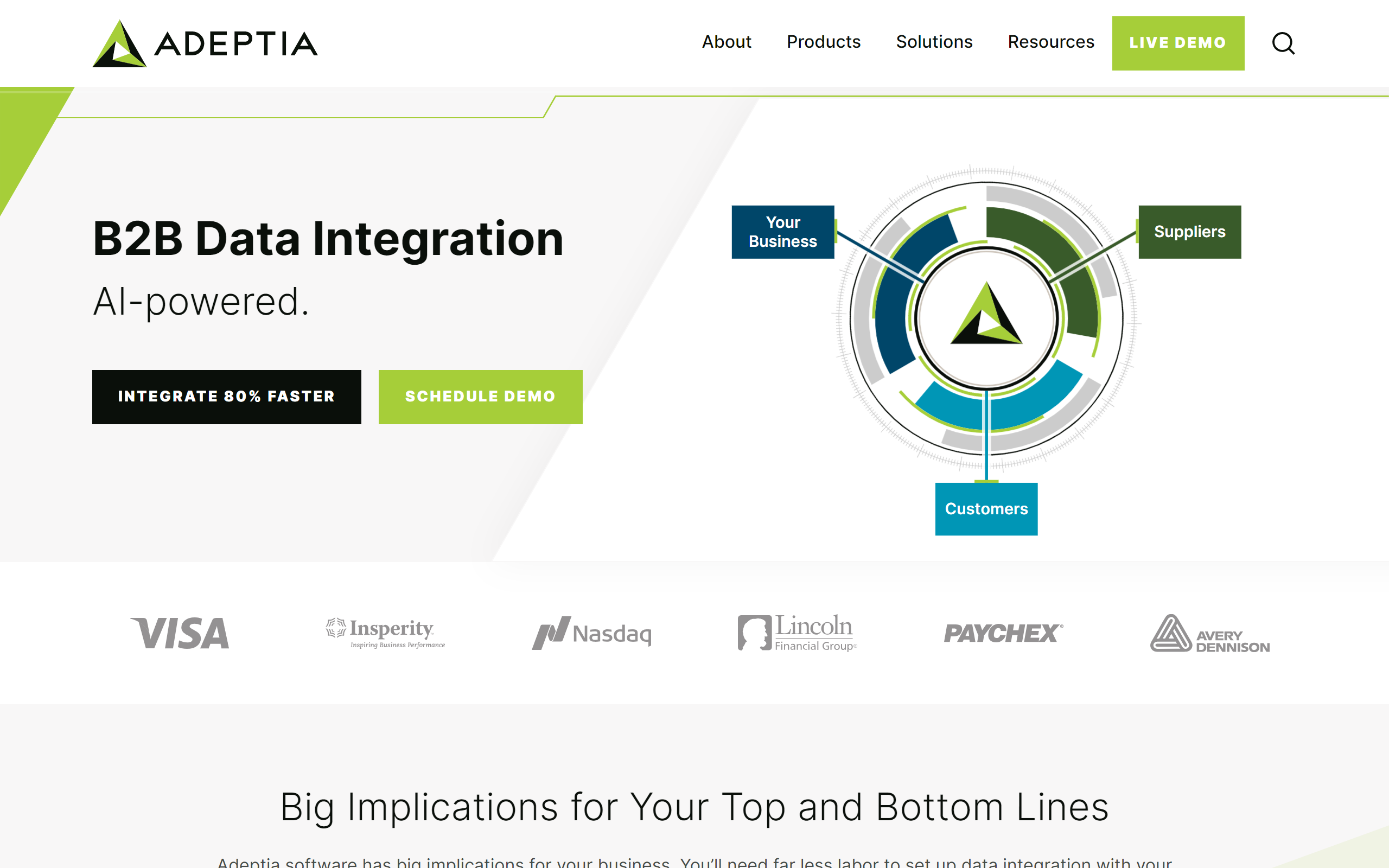
Adaptia
Adeptia is an integration platform that makes shuffling data between different systems as easy as possible. This is one of the data integration solutions for gluing together all your company's data sources into one flow.
Key Features
- Drag and Drop: Moving data between databases, APIs, cloud apps, and more is a breeze with Adeptia's super simple visual workflow designer. No coding is required.
- Connectivity: It can hook into all sorts of programs like SAP, Salesforce, Dropbox, and others. You can pull everything together from almost anywhere.
- DIY Integration: Build integrations for anything from simple file transfers to complex enterprise workflows without skills in coding.
- Precise Pipelines: Automate regular extraction, transformation and loading processes with built-in scheduling. Set it and forget it.
- Customization: Adeptia's API-based architecture allows tailoring capabilities to your unique needs through plugins and APIs. Make it your own.
20. Precisely
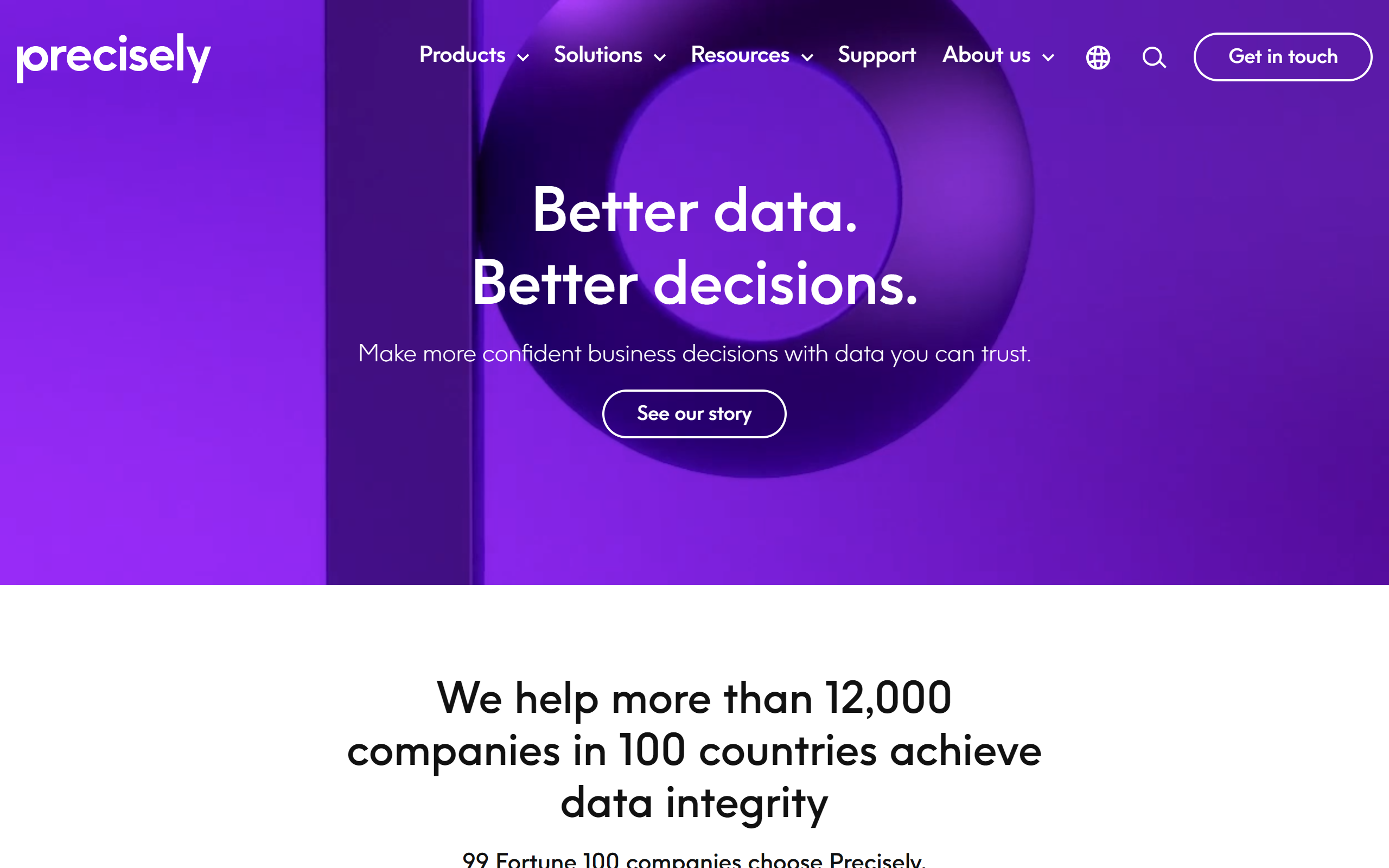
Precisely
Precisely is an analytics platform that helps companies turn their mounds of data into meaningful insights. With its unified data modeling, swift number crunching, and DIY usability, Precisely is a top choice.
Key Features
- United Data Front: It can assimilate info from all your different databases, apps, warehouses, and files into one consolidated view.
- Analysis Acceleration: Precisely's tech crunches numbers at super speed so you don't have to wait around forever for reports to generate. Think of it as keyword tracking tools for good SEO.
- Location Intelligence: This is where Precisely truly shines like that rockstar at a concert. It helps businesses harness the power of location data, making sure you have the complete context.
- Smart Automation: Set up regular processes to update metrics, records, and reports on the reg so you're always working with the freshest data.
- Safety: It focuses on top-tier data security and ensures that your precious data is protected against the big bad wolves out there.
21. CloverDX
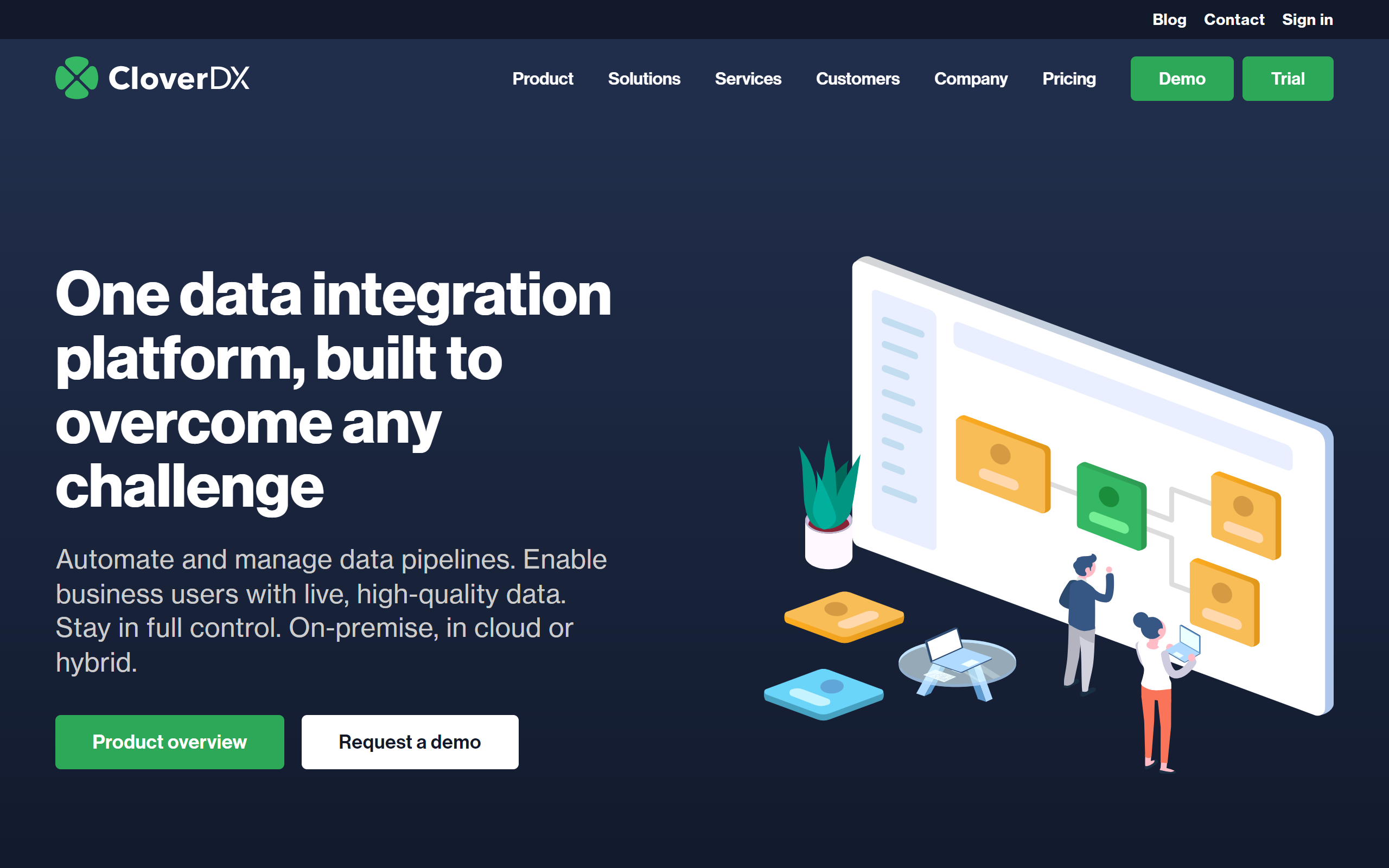
CloverDX
CloverDX is one of those neat data integration tools that helps companies slurp up information from different places and spit it out where they need it. Lots of companies use it for ETL workflows.
Key Features
- Connecting: It hooks into all kinds of databases, cloud apps, warehouse services and more using drivers and APIs. Tons of options.
- Graphical Jobs: Build your Extract, Transform, Load processes in a drag-and-drop interface rather than typing code. Breezy design.
- Transforming: As part of moving data around, it can modify column types, structures, filter records, unite datasets and the like.
- Scheduling: Whether it's scheduled refreshes or triggered runs, you can automate your extraction and loading processes.
22. Integrately
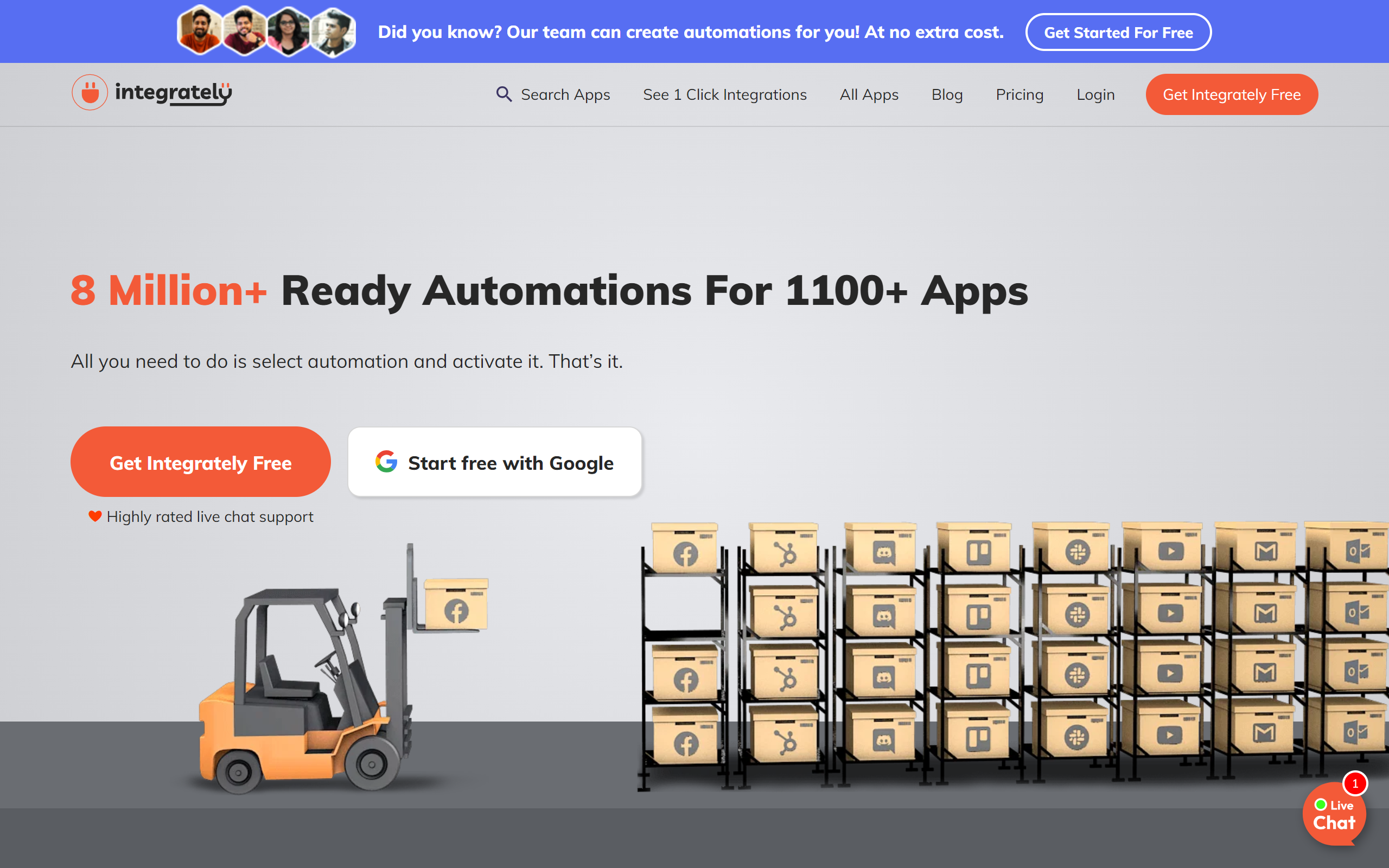
Integrately
You need to sync up databases nightly or build an ETL pipeline? This is one of the data integration tools that simplify the process and guide you through it.
Key Features
- Connectivity: It connects to all sorts of databases, cloud apps, file stores and other systems using drivers and APIs. Tons of options.
- Visual workflows: Build out Extract, Transform, Load style processes graphically instead of coding. Just drag and drop tasks.
- Transformations: It can clean column types, structures, filter records, join datasets and more when moving your data.
- Scheduling: Set up periodic or triggered refreshes so integrations run automatically in the background.
- Reusability: Tasks, flows and other objects can be reused elsewhere to avoid duplicative work.
23. Tray.io

Tray.io
Tray.io makes tying together apps and data extremely smooth with its wide range of connectivity, visual workflows, AI powers and features to suit all team sizes. Integrate all the things in several clicks.
Key Features
- Connectivity: It hooks into tons of databases, cloud apps, and other programs through APIs and drivers. Lots of options to link your stuff together.
- Automation: Build automated workflows visually or with code to turn boring tasks into cool robot workers. Set it and forget it!
- Integrations: Come with pre-made integrations for popular tools like Salesforce and Slack. And it's easy to set up custom ones if the out-of-the-box ones ain't enough.
- AI Magic: Their Merlin AI bud helps automate workflows with human style questions. It also builds and maintains your integrations way faster than doing it manual.
- Big Business Tools: For giant companies, it has scalable servers, security, controls and all that enterprise needs. But works just as sweet for smaller companies too.
24. Astera
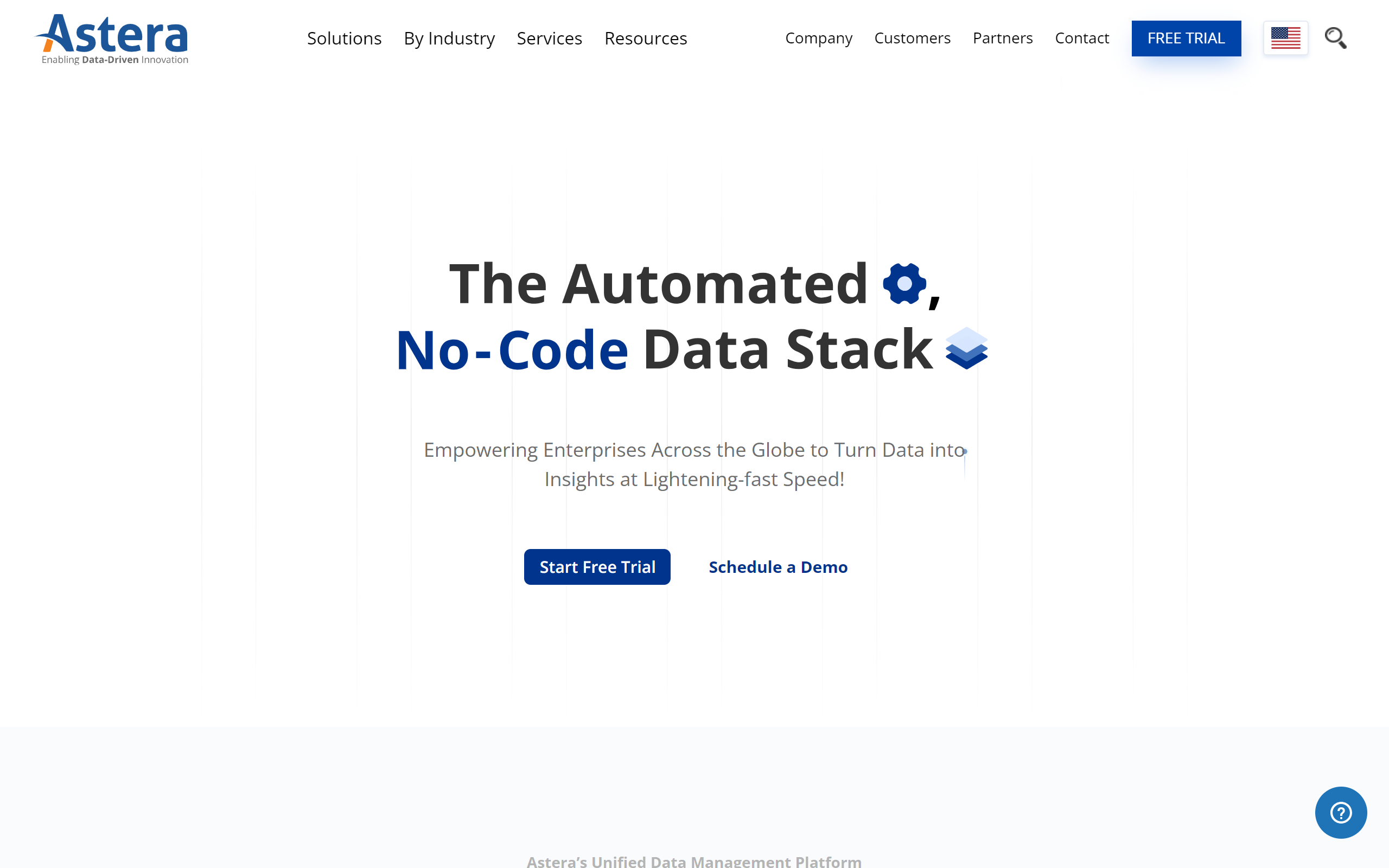
Astera
Astera is that tech-savvy buddy in your group who can seamlessly connect different gadgets and make them work together. Astera specializes in data integration, automation, and transformation.
Key Features
- Versatility: if you're dealing with databases, flat files, cloud apps, or even legacy systems, Astera can bring them all to the same conversation table.
- Data Quality & Cleansing: It identifies and fixes those pesky data inaccuracies, ensuring what you work with is pristine and reliable. It's like grammar checker tools, just as important!
- Fast Processing: It gives optimized processing capabilities, making sure data transfers and transformations are quick.
- Flexible Data Mapping: Astera's data mapping capabilities are a bit like having a GPS for your data journeys. It ensures that data from one source finds its correct destination in another, even if the terrain (or format) changes a bit along the way.
25. Insider
Insider sits among the best CDP (customer data platform) options around, enabling data from a deluge of disparate sources to be drawn together and interpreted holistically.
Key Features
- Breadth of Reach: The channels covered by Insider are incredibly varied, ranging from SMS and email to social sites like TikTok, Instagram, WhatsApp and more.
- Speed: Customer data that is integrated from your chosen platforms can deliver value three times faster than competing solutions in this space.
- Support: When you need help using Insider, its exceptional team is on standby to step up.
- Integrations: hundreds of integrations covering the likes of Shopify, Salesforce and beyond round out its appeal.
26. Coupler.io

Coupler.io is a data analytics and automation platform that allows you to integrate data into spreadsheets, data warehouses, and data visualization tools. The tool is widely used by marketing experts, product managers, financial specialists, data analysts, and other data-thirsty users.
Key Features
- Connectivity: Coupler.io offers access to more than 70 diverse data sources, ranging from marketing apps to analytics and time-tracking tools. You can also add custom sources without writing code.
- Automatic data refresh: You can set up your own schedule for exporting data. For example you can export Facebook Ads data to Google Sheets hourly, daily, monthly, or every 15 minutes.
- Free dashboard templates: As Coupler.io is often used for reporting and analytics, the platform offers its users a set of free templates.
- WebHooks support: It allows you to trigger imports from apps or events, and the other way round – your importers can trigger external events.
- Data transformation: In Coupler.io, you can blend data from different sources, sort it, change column names and order, add new columns, and create your own calculations—all in one place.
What Factors to Consider While Selecting Data Integration Tools?
Data Sources Supported 📊
Carefully analyze all the sources you need to integrate - databases, applications, file stores, SaaS platforms etc. Check if the tools have out of the box connectors for these or can build custom connectors via APIs. Missing sources can be a dealbreaker.
Scalability 💽
If you're a large enterprise handling terabytes of data daily, make sure the tools are highly scalable from the start.
Choose ones with elastic cloud infrastructure to dynamically add resources as data volumes rise. On-prem tools may not scale as needs grow. Real-time integrations also require adequate scalability to handle spikes in traffic.
Security and Compliance 🛡️
For sensitive customer or financial data, thoroughly evaluate security features like encryption of data in transit and at rest, authorization controls, access auditing. Look for compliance certifications if handling regulated sector data. Data leaks can be costly.
Real-time Data Availability 📂
Analyze your SLAs for providing real-time or near real-time visibility or actions based on new data. Batch jobs may not cut it. Choose streaming, CDC capable tools if your use cases require near instant data availability and actions.
Data Transformation📲
Carefully study your data wrangling needs. Check if the tools have advanced and extensible capabilities for tasks like custom validation rules, mappings between different schemas, merging tables, aggregate calculations, data cleansing, and other factors during integration processes.
This ensures the successful transformation of data between heterogeneous systems.
Wrapping Up
Whether you're a little startup just getting off the ground or a giant company with big data beaches to sort, there's bound to be a tool that suits your style.
Now comes the fun part - figuring out which one is the perfect match! But don't stress too much about moving data from A to B. Think instead about how these things can help your biz grow.
Make friends with a tool that empowers your vision.
One that flows with your workflow, not against it.
